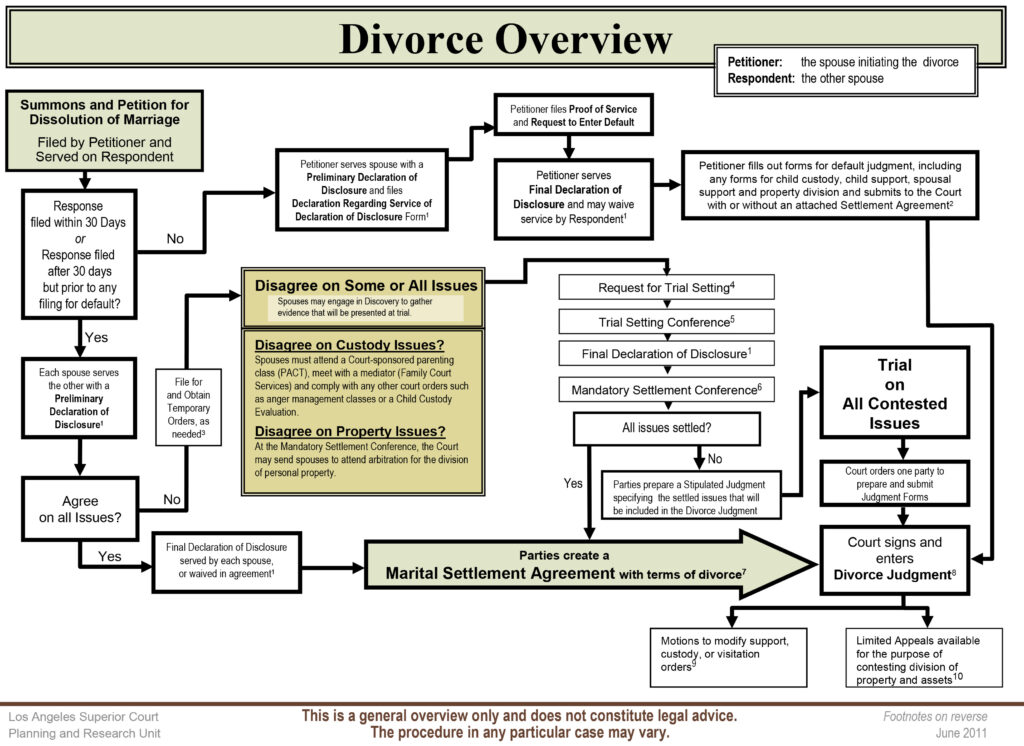Navigating the path of legal separation or divorce in California can be complex and emotionally taxing. This comprehensive guide simplifies the legal procedures involved and ensures that you stay well informed at every step. Whether you’re initiating a divorce or seeking a legal separation, understanding the process is crucial for a smoother transition to your new chapter. However, even with this guide, filing for divorce can be daunting. We recommend contacting an experienced divorce lawyer if you are considering starting this process.

Key Terms You Should Know When Filing for a Divorce in California

Before diving into the steps, familiarize yourself with these key terms:
- Petitioner: The person who initiates the divorce or legal separation process by filing the necessary forms with the court.
- Respondent: The spouse or domestic partner who responds to the petitioner’s forms.
- Declaration of Disclosure: Documents detailing each party’s financial information, which are exchanged but not filed with the court.
- Default: When the respondent does not file a response, allowing the petitioner to proceed without the respondent’s input.
- Legal Separation: A court order detailing the rights and responsibilities of each spouse, while they remain legally married.
- Serve: To provide in the proper legal way.
Step 1: Start Your Case

To start the divorce or legal separation process, the petitioner must fill out and file several forms with the court clerk, including the Petition—Marriage/Domestic Partnership (form FL-100) and a Summons (form FL-110). If children are involved, the Declaration Under Uniform Child Custody Jurisdiction and Enforcement Act (form FL-105) is also required. Information about filing fees and waivers is available on the California Courts website under “Filing Your Case.” The court clerk will then stamp and return copies of the filed forms.
Step 2: Serving Your Divorce or Legal Separation Papers

The next step involves serving the respondent with the forms from Step 1 plus a blank Response—Marriage/Domestic Partnership (form FL-120). It’s imperative that someone 18 or older, not the petitioner, perform this task. A proof-of-service form, like the Proof of Service of Summons (form FL-115), must then be filed with the court, indicating when and how the respondent was served.
This important step follows specific rules to make sure your spouse is fairly and legally informed about the start of the divorce or separation. Follow these rules to ensure everything remains valid and progresses without unnecessary hold-ups. Knowing and sticking to these rules maintains the legal process’s credibility and makes sure both people have a fair chance to engage and respond. For more information, check out our Step-by-Step Guide to Serving Divorce Papers In California.
Step 3: Disclose Financial Information

Simultaneously with Step 1 or within 60 days after filing the petition, the petitioner must complete and serve several financial disclosure documents on the respondent, which include the Declaration of Disclosure (form FL-140), Income and Expense Declaration (form FL-150), and more. These documents are not filed with the court but exchanged between parties. Both parties must submit a Declaration Regarding Service (form FL-141) to the court, confirming the exchange of disclosures.
Step 4: Completing Your Legal Separation or Divorce in California

Finalizing your legal separation or divorce in California can unfold in one of four distinct pathways, depending on whether your spouse (the respondent) responds and whether you both reach an agreement. Understanding these pathways is crucial to navigating this phase effectively.
When the Respondent Does Not File a Response (Default Cases)
No Response and No Agreement
If the respondent doesn’t file a response and there’s no agreement, you, the petitioner, must wait 30 days after serving the forms. Next, prepare a proposed judgment (form FL-180) along with the necessary forms, including:
- Declaration for Default, Uncontested Dissolution, or Legal Separation (form FL-170): This form certifies to the court that you meet the criteria for a default judgment.
- Notice of Entry of Judgment (form FL-190): After the judge signs your judgment, the court mails this form back to you as the official confirmation that your divorce or legal separation is final, specifying the official end date of your marriage or domestic partnership.
No response, but There Is a Written Agreement
If the respondent does not respond, but you have a written agreement, attach the signed and notarized agreement to the proposed judgment (form FL-180), along with:
- Request to Enter Default (form FL-165): This form requests the court recognize the lack of response from your spouse.
- Declaration for Default, Uncontested Dissolution, or Legal Separation (form FL-170).
- Notice of Rights and Responsibilities (form FL-192): Attach this to your judgment.
- Child Support Case Registry Form (form FL-191) and Income Withholding for Support (form FL-195), if applicable.
- Notice of Entry of Judgment (form FL-190).
When the Respondent Files a Response
Response with a Written Agreement
If the respondent files a response and you both agree, either party can file Appearance, Stipulations, and Waivers (form FL-130), the proposed judgment with the agreement attached, and:
- Declaration for Default, Uncontested Dissolution, or Legal Separation (form FL-170).
- Judgment (form FL-180): This is the court’s final order for your divorce, to which you attach your agreement.
- Notice of Entry of Judgment (form FL-190).
Response without Agreement
You’re headed for trial if there’s a response but no agreement. Preparation involves setting a trial date, final financial disclosures, attending a settlement conference, researching laws, gathering evidence, and potentially issuing subpoenas for witnesses.
In some instances, like disagreements over child support, you might resolve specific issues through a hearing instead of a full trial, using a Request for Order to ask a judge to make a decision.
Preparing for Trial

If your divorce or legal separation process leads to a trial, it’s essential to be thoroughly prepared. The steps below outline what you need to do to prepare yourself for this critical phase:
- Set a Trial Date: Your first action is to schedule a date for the trial. This ensures that both you and the court have a clear timeline for when your case will be heard.
- Complete Your Final Financial Disclosures: Before the trial, ensure that you have submitted all required financial disclosure documents. This comprehensive exchange of financial information with your spouse is crucial for a fair assessment of financial matters.
- Attend a Settlement Conference: A settlement conference offers a last opportunity to resolve issues without a trial. Here, both parties can negotiate terms to reach an agreement, potentially avoiding the need for a trial.
- Research the Law: Understanding the legal framework and statutes that apply to your case is vital. Researching the law helps you build a stronger case by aligning your arguments with relevant legal precedents and statutes.
- Gather Evidence: Compile all the evidence that supports your case. This can include documents, emails, photographs, financial records, and any other material that can substantiate your claims or counter those of your spouse.
- Conduct Discovery: Formal requests for information from your spouse, known as discovery, are a key part of trial preparation. This process may involve written questions (interrogatories), document requests, and depositions to gather all necessary information for your case.
- Subpoena Witnesses: If there are individuals whose testimony could support your case, you may need to issue a subpoena to ensure their appearance in court. Witness testimony can be crucial in providing firsthand accounts relevant to your case.
- Plan Your Testimony: Consider what you will say to the judge. Planning your testimony helps you present your case clearly and effectively, focusing on the facts and information that best support your arguments.
- Prepare a Trial Brief: A trial brief can be incredibly helpful but is not always required. This document outlines your case, the laws that apply, and the outcome you seek, serving as a guide for the court to understand your arguments and the basis for your requests.
In your quest for divorce in California, taking these steps seriously enhances your readiness for trial, helping to present your case in the most coherent and persuasive manner possible. Remember, thorough preparation is key to navigating the complexities of trial proceedings effectively.

Contact Our Family Law Attorneys Today
If you need family law services in Orange County or Los Angeles, contact us today. We are here to offer you knowledgeable, compassionate, and assertive legal assistance in all aspects of family law.
